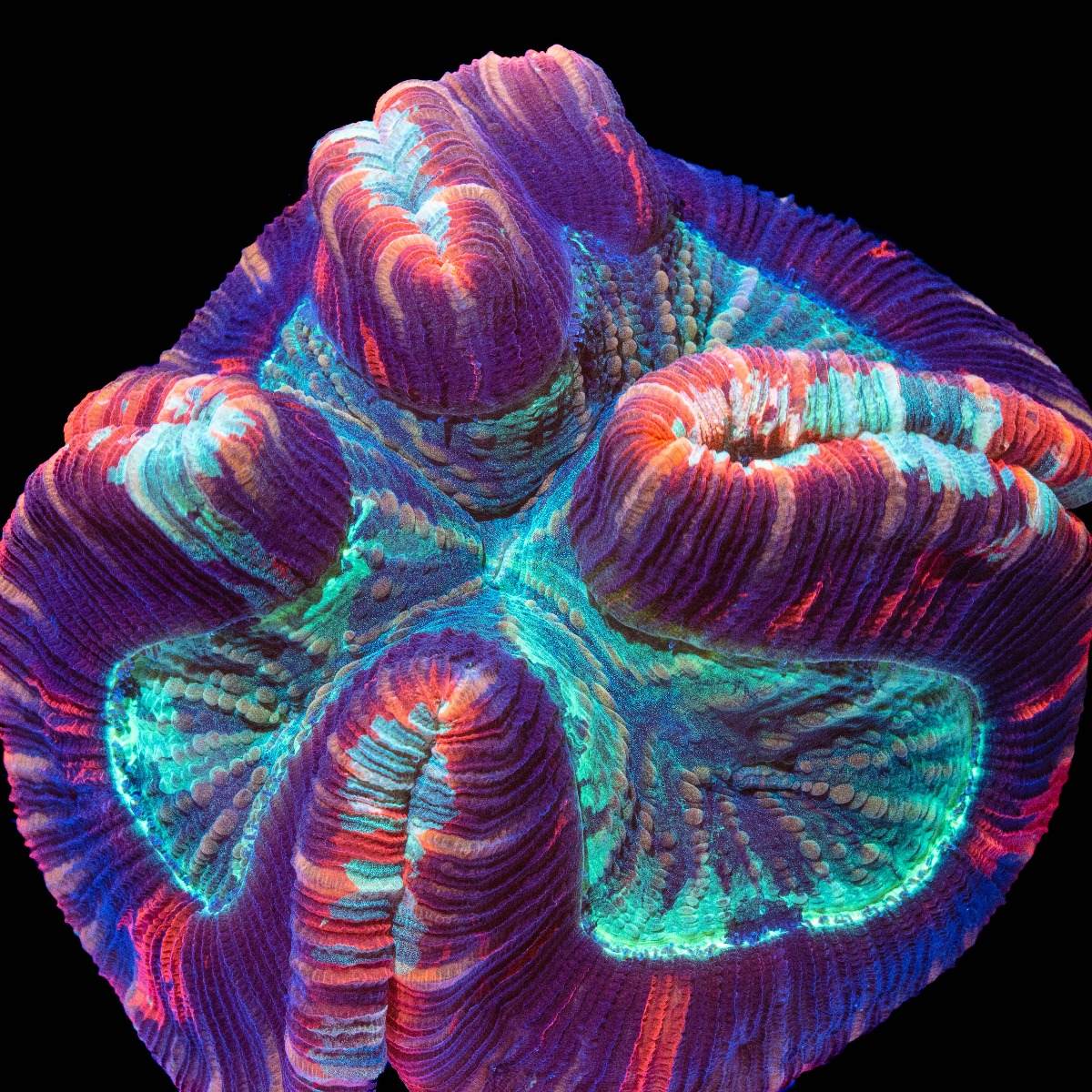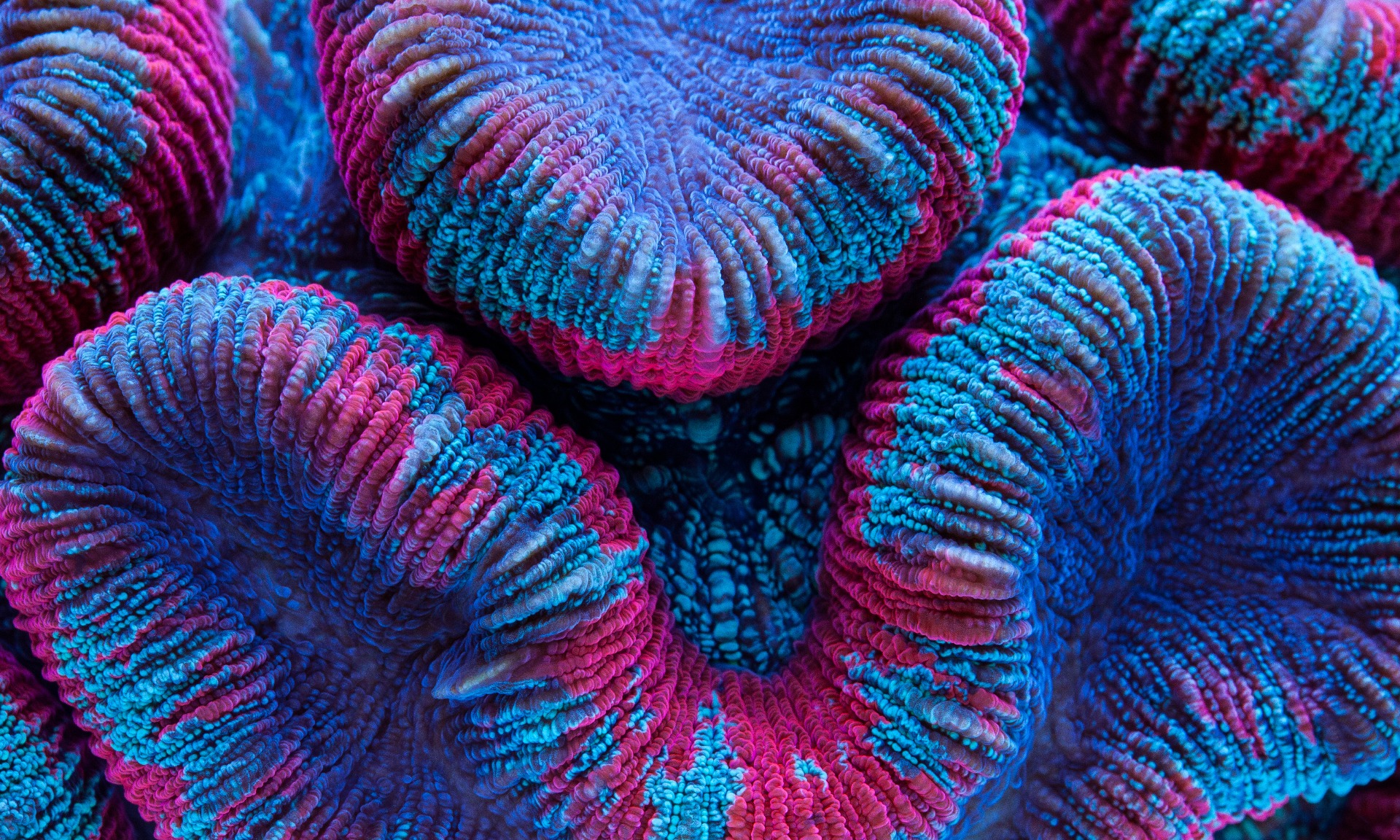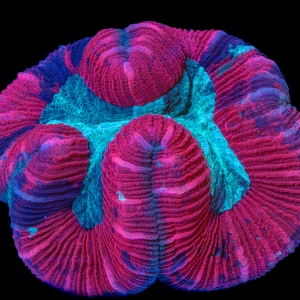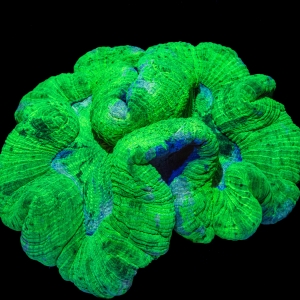We can't find products matching the selection.
Filter
My Wish List
![]() Trachyphyllia Open Brain Coral Care
Trachyphyllia Open Brain Coral Care
Trachyphyllia are commonly referred to as an Open Brain coral and are one of the most popular large polyp stony corals among beginners and advanced reef hobbyists alike. Like with any coral, their naming convention can bounce around a bit as new information is uncovered.

Rainbow Trachyphyllia
![]() Taxonomy
Taxonomy
Let’s briefly look at their taxonomy. For those of you who aren’t into scientific lingo, taxonomy is the part of biological study that deals with the classification of organisms and explores the similarities and differences between them. It can be useful to know the taxonomy of your coral as such information can provide insight into its needs based upon its close relations that were similarly classified.
Corals used to be grouped based on their visual features. Nowadays with the developments in genetic sequencing corals are grouped according to their genome and less so on their physical characteristics. Having said that, this is a cutting edge field and will likely be a work in progress for a long time. The tricky thing is finding sequences of DNA that are actually diverse enough to show any differentiation whatsoever because so much of the coral genome is the same from coral to coral. As more study is done on corals they are periodically reclassified.
Trachyphyllia are currently part of the Merulinidae family, these corals have had many names attributed to them and over the years and have had their fair share of scientific reclassification. At different times, they have been called both Trachyphyllia as well as Wellsophyllia. According to the World Register of Marine Species Trachyphyllia radiata, and Wellsophyllia radiata are all now grouped under the latin name Trachyphyllia geoffroyi. So if you hear reefers talking about ‘Trachys’ or ‘Wellsos’ they are in fact talking about T.geoffroyi.
So now we know what they are name wise lets look at what that means to us as reefers.
![]() Coral Background
Coral Background
Trachyphyllia are a large polyp stony coral that is commonly referred to as an Open Brain Coral. They are a free living coral meaning that colonies with the ability to inflate their tissues and move around with the help of the water current. If they happen to find themselves in undesirable conditions they can attempt to remedy the situation by moving themselves. In an aquarium setting this movement is pretty limited because even in high flow aquariums, it really does not compare with the ocean.

Tri-Color Trachyphyllia
Trachyphyllia are normally a single large polyp. On occasion you do find colonies that consist of one larger colony and then what appears to be daughter colonies surrounding it. This looks as though the coral may be ‘budding’ which is an asexual reproduction method but that is probably not what is going on here. What is actually happening is during the coral spawning events you will get a ‘stray spawn’ landing and settling on an existing colony. When they grow up it looks like a double or triple-headed Trachy. For whatever reason these smaller colonies are frequently seen from Trachyphyllia imported from the West Coast of Australia. The East coast of Australia has some of the most amazing and huge multicolored show pieces and Indonesia tends to have smaller colonies available again in really striking colors. There is a huge range in the skeletal growth and you can generally tell from the appearance of a colony where it was collected from.
Trachyphyllia are one of the most highly desired and prized corals among collectors of large polyp stony corals due in large part to their diverse coloration and the intensity of those colors. There are monochromatic fluorescent green striped colonies but there are also some absolutely stunning rainbow-colored colonies that find their way into the hobby. These show grade colonies can have yellow, red, orange, pink, green, lime colors and come as single mouthed or multi mouthed large folding colonies. Although you don’t hear as much said about Trachyphyllia as say, more popular corals such as Scolymia or Acanthophyllia, I think we can all agree that these corals are every bit as beautiful.

Now that we’ve gone over some background info on Trachyphyllia, let’s dive into their care requirements. Let’s first cover the topic of nutrition which I will break up into lighting and feeding.
![]() Lighting
Lighting
Open Brains are photosynthetic corals, meaning they get nutrients from the products of photosynthesis carried out by symbiotic dinoflagellates called zooxanthellae living in their flesh. Zooxanthellae utilize chlorophyll to absorb light and produce simple sugars that the coral can consume for energy.
While some corals are more light loving than others, Trachyphyllia tend to be less demanding. In fact, they probably fare better in less intense lighting conditions. We primarily keep Trachyphyllia in low to medium light intensity here at Tidal Gardens which is around 50 to 100 PAR. If your tank is higher in light, it will take some time for this coral to adjust to its new surroundings. When in doubt, try lower lighting intensities until it is clear that the coral is stable before ramping it up.
Low Light


Lighting is a loaded topic, so for a more in-depth discussion of lighting, please see our Deep Dive article.
If you have a colony of Trachyphyllia and want to experiment with higher light, remember that lighting that is too bright risks burning the coral and it will happen quickly. If you start to see the coral starting to turn lighter and bleach out, it is time to move it to a dimmer location. It is possible to for a Trachyphyllia that has bleached to recover but it can take a long long time. It may also permanently change color having expelled all the zooxanthellae of a certain type.
What may help is to aggressively feed the coral during this time, so let’s quickly cover the topic of direct feeding.

Frozen Tundra Trachyphyllia
![]() Feeding
Feeding
In addition to photosynthesis, these corals are adept feeders that can grab and consume a wide variety of foods ranging from coral-formulated sinking pellets to frozen food such as brine shrimp, mysis, and krill.
Trachyphyllia are up there with Scolymia for putting on dramatic feeding displays. By day they are a fluffy pillow of smooth multicolored tissue. But as soon as they detect the faintest hint of food in the water their feeding response is activated turning them into an explosion of hungry tentacles. I have noticed that the more regularly the Trachy is fed, the easier it is to feed it in the future. A well-fed Trachy’s tentacles are out more and the coral as a whole is more responsive to food in the water.
It is tempting to dump lots of food on them but it is possible to overfeed. Most of the nutrition Trachyphyllia needs will come from the lighting and they will be absorbing other nutrients from the water. The risk of overfeeding is that it can pollute the water that can be hard to remedy. Aim to feed multiple times a week to allow the coral to expel the waste produced.
Target feeding LPS can always be tricky with an aquarium full of hungry fish as they will often steal it directly from the coral once you have fed it. The bigger concern with feeding is that certain fish and inverts such as shrimps and crabs can cause major damage to a coral when they go after the food. I’ve literally lost entire heads of corals the day after a big feeding and it is pretty clear one of my cleanup crew tore the polyp apart. Fish stealing food out of the coral’s grasp is one thing but if you have tank mates that rip a coral apart to get at the food, something more drastic has to be done.
There are a few different ways to try and combat this. Firstly – distraction! When it is time to feed your corals try adding a fresh strip of Nori to the other end of the tank. If you keep the fish occupied the coral should have time to digest its meal. If that isn’t successful another option is to create a DIY feeding barrier. A good way to do this is to save an old candy or pretzel container and use it to go over the top of the coral at feeding time (don’t forget to weigh it down though!). You could even go as far as drilling a hole in the top and installing a feeding tube that you can squirt the food directly into. There are a few options and plenty of DIY ideas online to solve this problem. If you want to get even fancier I am sure there are plans on the internet for 3D printed coral cages that would allow for feeding corals.

![]() Water Flow
Water Flow
Trachyphyllia appreciate low to medium flow. There are two things that I am looking to accomplish with flow for this coral. The first is to give it enough flow to keep it clean. Detritus build-up can cause the coral to die back where it collects. Providing elevated flow around the coral can prevent this accumulation. Even moderate flow can serve to keep the coral clean as the coral does a good job of slugging off debris that settle on it.
You will know if you are overdoing it if the flow is slamming one side of the coral and it is drawn tight to the skeleton all the time. If this sort of flow isn’t adjusted it can cause the coral to die as the tissue will rub against the skeleton causing damage.
Providing periodic low flow or even zero flow is beneficial for this coral for the purposes of feeding.
![]() Chemistry
Chemistry
Let’s talk a little bit more about Chemistry. As I mentioned previously there are problems associated with overfeeding so let’s talk about phosphate and nitrate. Phosphate and Nitrate are great general measurements of water cleanliness. They show up mainly in the food we provide the tank but decaying plant and animal matter in the aquarium can also elevate their levels in the water.
We generally shoot for about 5-10 ppm nitrate and .05 to .1 ppm phosphate.
If Nitrate levels get too high corals may react negatively by taking on drab coloration or suddenly dying back in extreme cases. If Phosphate levels are too high, it may feed into an unwanted algae bloom or spur on the growth of other undesirable organisms that can stifle the growth of corals.
For a short period there was a push in the hobby to have near zero levels of nitrate and phosphate. This is done through techniques like carbon dosing or GFO which can aggressively bring those numbers down. Ultra low nutrient levels though come with their own sets of issues. There is such a thing as too clean and I would argue the problems caused by near zero nutrient levels are much worse than those caused by an abundance of nitrate and phosphate.
Corals require some level of nitrate and phosphate available to them. When starved out, the corals first take on a shrunken emaciated look and then they start dying off. After that there is a risk for blooms of unwanted organisms such as brown dinoflagellates that thrive in ultra low nutrient conditions.
For Trachyphyllia specifically, I would rather see Nitrate and Phosphate levels on the high side than barely detectable because we have kept them in systems with very high nutrient with little to no difficulties.
Moving on from the nutrient parameters, let’s consider building block parameters, Calcium, Alkalinity, and Magnesium.
Because Trachyphyllia are stony corals, these are the three major chemical parameters that are needed by the coral to build its skeleton.
Starting first with Calcium… Calcium is one of the major ions in saltwater. In the ocean, its level hovers around 425 parts per million. As a coral grows calcium is absorbed from the water and used to forms its calcium carbonate skeleton.
Alkalinity a collection of ions that generally equate to carbonate availability in the water. Technically it is the amount of acid required to lower the pH of saltwater to the point bicarbonate turns into carbonic acid. If you have more alkalinity, it can soak up more acid. Less alkalinity and you have less buffering capacity making the tank more susceptible to chemical changes.
In practice alkalinity tends to be the parameter that fluctuates the most, so if you can only manage one test, test for alkalinity. In natural sea water, the alkalinity of the water measures around 7 or 8 dkh though most salt mixes these days mix up closer to 8 to 9 dkh. Some aquarists like to overload this parameter a little and keep their tanks around 10 or 11 dkh under the belief that having elevated calcium and alkalinity in the water contributes to faster stony coral growth.
Last point I will make about water chemistry is that stability is the goal. Even if one or two parameters are “off” a little bit, it is better for them to remain consistent at that level than for the hobbyist to hurriedly try to change the values trying to hit a particular target value. Here is where keeping an eye on Magnesium can help. Raising both calcium and alkalinity together can be tricky because of how they interact. Calcium ions and carbonate want to react with one another. Addition of a calcium supplements often comes with a corresponding fall in alkalinity levels and vice versa. If you are experiencing this in your systems, it is normal, but wild swings are not. If you are experiencing dramatic swings of calcium and alkalinity every time you use an additive, you may want to look at your Magnesium levels. In short, Magnesium acts to increase the overall bioavailability of alkalinity compounds in the water. In the ocean, Magnesium sits at about 1350 ppm.
That should give you a little bit of background on the chemical parameters to keep an eye on.
Trachyphyllia are a somewhat slow growing LPS. Their fleshy portion grows quickly, but not so much their skeleton. Still, as they grow and you add more stony coral tank mates, it is wise to test more frequently to make sure your chemistry is keeping up.

Green and Yellow Trachyphyllia
![]() Aquaculture
Aquaculture
So now we can care for Trachyphyllia can we breed them, or frag them?
This simple answer is not really. Trachys are an extremely slow grower and take many many years to recover their desirable shape after being cut if the cut is successful in the first place. One future solution may well be sexual reproduction and with the advances in the area happening rapidly it really isn’t out of the question although a considerable grow out area would be required which undoubtedly result a huge price increase. Sexual breeding could also potentially produce some interesting hybrids and color morphs so maybe those additional prices would be worth it? It’s all food for thought and an exciting area that the hobby is advancing towards fast.
![]() Pests
Pests
The last area it is worth talking about before we wrap this up are pests
Trachyphyllia do not usually struggle with pest issues but there are a few things that are worth keeping an eye out for. First up are Gall Crabs. Crypto-chi-rid-ae are a family of crabs that burrow into coral skeletons and form galls - a kind of abnormal growth. Most of the male gall crabs are free living but it is those pesky females that are the ones causing the abnormal growths. It is thought that the crabs feed on the mucus produced by the coral as well as detritus but I have included them here in the pest section because it is common that if there is a gall crab present the coral will not thrive and Trachyphyllia as well as Catalaphyllia are one of their preferred hosts. These crabs are easily removed from their holes so it is worth inspecting your colony upon purchase.
The only other pest that is worth mentioning are flat worms and these can plague LPS generally rather than Trachyphyllia specifically. A quick dip normally remedies the problem and if caught early will cause no real issue. Long term large quantities of these flatworms will inhibit the amount of light reaching the coral and will reduce its overall health and potentially irritate so that it does not expand as it should. Luckily these types of flatworms are not as deadly as the dreaded Acropora Eating Flat Worms and can be dealt with swiftly once spotted.
![]() Conclusion
Conclusion
Ok, that about does it for Trachyphyllia. So what kind of tank is Trachyphyllia best suited for? Trachyphyllia are a show-piece LPS in a mixed reef and can introduce an amazing burst of color to the lower sections of the reef. The rainbow paint splatter varieties in particular can hold their own as a signature show piece item on par with much more expensive corals such as scolymia or Acanthophyllia.
Hopefully this blog is helpful for those looking to try them for the first time. If you would like more information or perhaps purchase Trachyphyllia for your home aquarium, I invite you to look through our LPS section and see what we have in stock. We are always on the lookout for new and interesting color morphs of this coral to add to our collection, and hopefully yours as well.
Until next time, happy reefing.
